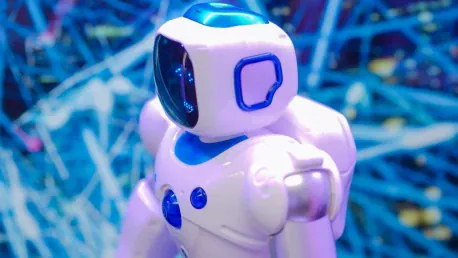The world of robotics is evolving at an unprecedented pace, with innovations that range from the incredibly useful to the profoundly strange. Initially designed for repetitive tasks in manufacturing and logistics, robots are now advancing into numerous other fields, showcasing a variety of advanced technologies and functional designs. This article delves into eight of the weirdest and most advanced robots currently in existence, exploring their specific functionalities, designs, and potential future applications. The journey begins with examining injectable nanobots and spans a wide range of robots, each uniquely addressing different needs and applications.
Injectable Nanobots: Tiny Marvels of Medical Technology
Injectable nanobots, developed by researchers from the University of Edinburgh’s School of Engineering, represent a significant advancement in medical treatments. These miniature robots, about one-12th the size of a red blood cell, are formed from blood-clotting drugs and coated with a special material that melts at a specific temperature. By using external magnets and medical imaging, these nanobots can be precisely guided through blood vessels to deliver drugs directly to targeted areas of the body. This technology, reminiscent of science fiction, offers a promising future for targeted drug delivery, potentially revolutionizing how we treat various medical conditions.
Once they reach their destination, the magnets cluster the nanobots together, causing them to heat up, melt, and release their drug payload. The ability to target specific areas in the body enhances the efficacy of medical treatments while minimizing side effects. This innovative approach could transform how diseases like cancer and chronic illnesses are treated, providing a more efficient and less invasive method for drug delivery. The development of injectable nanobots underscores the ongoing integration of cutting-edge technology in the medical field, offering a glimpse into a future where microscopic robots could perform complex medical tasks.
Atlas by Boston Dynamics: The Agile Bipedal Robot
Atlas, an evolving bipedal robot platform by Boston Dynamics, is renowned for its dexterity and parkour skills. Recently, Atlas has been programmed to “wake up” from a face-down position using rotatable hip joints and flexible movements. This unsettlingly natural movement demonstrates Atlas’ advanced articulation and potential adaptability to various fields. Its ability to perform complex movements could make it suitable for diverse applications, from industrial tasks to search and rescue missions. The continuous advancements in Atlas’ capabilities highlight the potential for robots to perform tasks that were once thought to be exclusively human.
Atlas’ ability to perform such dynamic and coordinated movements opens up a wide range of potential applications. In industrial settings, Atlas could assist with tasks that require both strength and precision, reducing the need for manual labor. In search and rescue operations, the robot’s agility and resilience could be invaluable in navigating hazardous environments and providing assistance where human presence might be dangerous or impractical. The evolution of Atlas reflects a broader trend in robotics, where the emphasis is on developing machines that can autonomously perform complex tasks in dynamic and unpredictable environments.
Ameca: The Humanoid with Realistic Facial Expressions
Ameca, a second-generation humanoid robot created by Engineering Arts, is touted as “the world’s most advanced robot.” It can display realistic facial expressions using a combination of generative artificial intelligence and malleable facial material. Ameca’s facial movements are uncannily human-like, contrasting sharply with its skeletal frame and visible hydraulics. Although Ameca is not yet deployed commercially, its creators envision its use in social care or as a receptionist, working alongside human colleagues. The development of such human-like robots opens up new possibilities for social and cultural integration of robots in everyday life.
The potential applications of Ameca go beyond mere technology showcases. In social care settings, humanoid robots like Ameca could provide companionship and support to elderly individuals or those with disabilities, reducing the burden on human caregivers. As receptionists or customer service agents, these robots could handle routine inquiries and tasks, allowing human employees to focus on more complex interactions. The uncanny realism of Ameca’s facial expressions also highlights the progress being made in creating robots that can engage in more natural and meaningful interactions with humans, bridging the gap between machines and people.
Torso by Clone Robotics: Mimicking Human Movements
Torso by Clone Robotics uses a sophisticated system of battery-operated water pumps and valves to move artificial bones and muscles, mimicking the human torso from the pelvis upwards. Covered in ghostly white skin, Torso’s movements are currently somewhat jerky but are being refined to appear more natural. Clone Robotics aims to employ this technology in future humanoid robots designed for assembly line tasks, household chores, and telehealth delivery. The ability to replicate human movements with such precision could revolutionize various industries, making robots more versatile and efficient.
The advancements in Torso’s design highlight the ongoing efforts to create robots that can seamlessly integrate into human-centric environments. In manufacturing, robots that mimic human movements could perform tasks with greater precision and adaptability, reducing errors and increasing productivity. In household settings, such robots could assist with daily chores, improving the quality of life for individuals with limited mobility. The potential for telehealth delivery is particularly significant, as robots like Torso could enable remote medical consultations and care, expanding access to healthcare services for individuals in underserved or remote areas.
mCLARI: The Tiny Spider-Bot for Search and Rescue
mCLARI is a tiny “spider-bot” inspired by arachnids and measuring only 0.8 inches (2 centimeters) long. It features four leg modules that enable it to move in two dimensions, allowing the robot to change shape and navigate through tight spaces and obstacles. While it lacks advanced AI processing and requires remote control, mCLARI’s adaptive design makes it ideal for search and rescue operations in difficult-to-reach areas, such as collapsed buildings or disaster zones. The potential applications of mCLARI in emergency situations highlight the importance of developing robots that can operate in environments that are hazardous or inaccessible to humans.
The ability of mCLARI to adapt to its surroundings and navigate through challenging terrains underscores its potential as a valuable tool in emergency response scenarios. In disaster-stricken areas, timely search and rescue operations can be critical to saving lives, and mCLARI’s compact size and maneuverability make it well-suited for such tasks. The robot’s design also offers insights into how bio-inspired robotics can address real-world challenges, leveraging the unique characteristics of natural organisms to create more effective and adaptable machines. The development of mCLARI reflects a broader trend in robotics, where the focus is on creating specialized robots that can perform specific functions with high efficiency.
Desdemona by Hanson Robotics: The Cultural Robot
Desdemona, developed by Hanson Robotics, is a humanoid robot and a music star with a “personality core” database filled with traits and memories. Unlike other robots, Desdemona is designed to be a cultural figure, replicating realistic facial expressions thanks to its synthetic skin and large-language model (LLM). It is intended to interact with humans in a social and cultural context, offering a glimpse into how robots could integrate into human society beyond technology demonstrations. Desdemona’s development underscores the potential for robots to play roles in entertainment and cultural sectors, bridging the gap between technology and human interaction.
The emergence of robots like Desdemona highlights the growing interest in developing machines that can engage with humans on a more personal and emotional level. In the entertainment industry, such robots could offer new forms of interactive experiences, blending technology with artistic expression. The ability to store and retrieve traits and memories also opens up possibilities for creating robots with distinct personalities, enhancing their ability to connect with people. Desdemona’s role as a cultural figure provides a unique perspective on how robots can be integrated into various aspects of human life, beyond purely functional applications.
MenteeBot: The Learning Robot
MenteeBot is a retro-looking robot with articulated hands that, despite its appearance, is designed to learn and adapt to different tasks using AI models. Its “Sim2Real” system accelerates the transition from simulated to real-world tasks, backed by reinforcement learning techniques. MenteeBot can assist with tasks ranging from pushing trolleys for wheelchair users to warehouse automation and domestic chores. The potential for MenteeBot to be ready for a variety of roles by 2025 highlights the rapid advancements in AI and machine learning, paving the way for more intelligent and adaptable robots.
The ability of MenteeBot to learn and adapt to new tasks reflects the broader trend towards creating robots that can operate autonomously in dynamic and unpredictable environments. By leveraging advanced AI models and reinforcement learning, MenteeBot can continuously improve its performance and expand its capabilities, making it a valuable asset in various settings. In healthcare, such robots could provide vital support to individuals with mobility issues, enhancing their independence and quality of life. In industrial and domestic environments, MenteeBot’s adaptability and versatility could lead to more efficient operations, reducing the need for human intervention in routine tasks.
Casio Moflin: The Robot Pet for Companionship
The field of robotics is progressing at an unprecedented pace, introducing innovations that range from incredibly practical to extraordinarily peculiar. Originally developed for repetitive tasks in manufacturing and logistics, robots have now found their way into a multitude of other sectors. This rapid evolution features advanced technologies and sophisticated designs. This article explores eight of the most bizarre and cutting-edge robots currently available, detailing their specific functions, unique designs, and potential future roles. Beginning with injectable nanobots, we venture into a diverse array of robotic innovations, each addressing various needs and applications in unique ways. From medical advancements to household assistance and entertainment, these robots illustrate how the field is expanding beyond its traditional boundaries. As robotics continue to evolve, their impact on society and various industries will undoubtedly become more significant, leading to new possibilities and perhaps reshaping the way we live and work.









